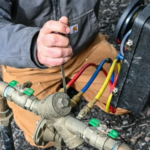Backflow testing remains a powerful global prevention procedure for water supply systems’ reliability.The concept is fundamental: to prevent the potable water from being contaminated by the backflow of undesirable substances. As critical for backflow testing, several important components are required for the procedure to be carried out successfully. These are Certified Testers with relevant equipment. This testing conforms to the local bylaws, test reporting, and documentation.
Here’s a detailed discussion of what is needed for backflow testing Los Angeles:
Certified Backflow Tester
Essential personnel when carrying out the tests include a certified backflow tester. Certification validates that the tester has the requisite know-how to test backflow prevention devices. Certification usually entails completing some training and passing an assessment test, touching on different forms of backflow prevention assemblies and test procedures. Most jurisdictions make it mandatory for testers to get a license renewal after some time to check whether they have updated their knowledge regarding the testing laws and techniques.
Appropriate Testing Equipment
The various backflow testing equipment required for the testing process must be appropriate for the desired test result. This consists of devices such as differential pressure gauge, backflow test kit, and spare parts, including hose and fittings suitable for the backflow prevention assemblies. Some of these requirements include calibrating the equipment used to provide accurate measurements. Correct equipment ensures the identification of problems like leakages, fluctuations in pressure, and defective valves that pose serious challenges to water delivery.
Backflow Prevention Device conducive to be accessed
Some of the requirements that need to be met are access to the backflow prevention device to test the same. This often entails contact with property owners or the managers of the facility that houses the device to guarantee its availability and organize testing and calibration in a way that does not interfere with water service significantly. At times, access may involve working in small spaces or areas with some form of jeopardy to the workers’ lives, for example, spaces at high altitudes or close to flammable materials.
Accurate Record-Keeping
Documentation is particularly critical regarding backflow testing because a record holder must produce accurate writing. This entails recording information such as the test results, condition of the backflow device, activities done in the servicing process, and others recommending further action. A well-kept record also records the device’s performance, including adherence to legal and policy guidelines. It also offers relevant information for diagnosis and potential testing in the future if necessary.
Testing Procedures and Protocols
Adherence to testing processes and guidelines is a crucial factor that maintains inter-organization consistency in backflow testing services. Such activities may include turning off the flow of water downstream, connecting test instruments, taking measurements in pressure differentials, and physically observing the device’s function. Maintenance of predetermined testing guidelines is crucial because the results attained should be comparable to previous results, thus serving the purpose of observing recurring cases or habits.
Safety Measures
It is advisable to incorporate safety measures to reduce the risk of harm on the tester’s part and the water system’s distortion. This involves selecting the right and adequate PPE, utilizing correct lockout/tag-out procedures to avoid water flow during tests, and keeping measures of working in vulnerable areas as necessary. Safety measures also include assuring that any chemicals or contaminants are handled appropriately to reduce the risk of suffering from the chemicals or polluting the environment.
Final Thoughts
Backflow testing is not a simple task that only requires a technician, tools, gadgets, and records; it includes expertise, access to devices, understanding of the rules and regulations, documentation, compliance with protocol, and safety. Collectively, these elements guarantee that the testing is precise, credible and it meets other standards regarding the protection from health hazards of the population.





